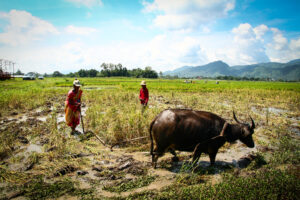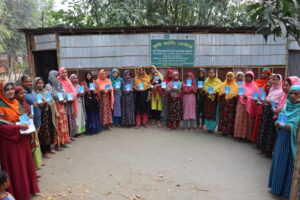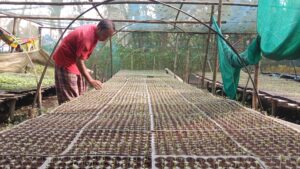by Danica Louise C. Sembrano
IRRI researchers link food availability and access as key factors influencing diet, nutrition, and health in rural food environments of low- and middle-income countries. This calls for interventions focused on reducing unhealthy food options and making nutritious foods more available and accessible.

Behind every meal is a food environment—homes, schools, workplaces, neighborhoods —spaces where various factors interplay and shape one’s dietary habits. In the rural areas of low- and middle-income countries (LMICs), where 43% of the global population lives, research on food environments remains overlooked, but understanding them can be key to developing effective strategies to improve public health and combat all forms of malnutrition.
Dr. Samira Choudhury, an agricultural economist at the International Rice Research Institute (IRRI), spearheaded a comprehensive review synthesizing research studies that link LMICs’ rural food environments to diet, nutrition, and health outcomes. This review involved 19 studies across 11 countries, including China, Mexico, the Caribbean, Thailand, Namibia, South Africa, Myanmar, Kenya, India, Vietnam, and Uganda. It provided IRRI researchers with valuable insights on how rural food environments can be improved to enhance public health nutrition.
Food Availability and Access in Rural Populations
The burden of malnutrition is striking among rural populations. According to the Food and Agriculture Organization (FAO), stunting rates (low height-for-age) are 1.6 times higher and wasting (low weight-for-height) is 1.4 times more prevalent in rural areas compared to urban areas worldwide. Delving deeper, Dr. Choudhury’s team examined the food environments of communities, neighborhoods, and schools in selected rural LMICs, with populations ranging from adults to adolescents and children.
Among the two key food domains (external and personal), availability and accessibility were found the most prominent factors to impact public health. Availability, or the presence of the food source, emerged as the most frequently studied dimension, with evidence showing its strong linkages to diet, nutrition, and health. For instance, a long-term study by the China Health and Nutrition Survey, conducted in 2004, 2006, 2009, and 2011, found the relationship between the number of fast-food outlets in a neighborhood and higher biomass index (BMI) of both adult men and women. BMI is a reliable indicator of a person’s body fat, which can serve as a risk factor for numerous health problems.
For rural Ugandan women, food seasonality affected their dietary practices. Fruits and vegetables were most commonly sold by vendors, followed by packaged and dried foods, and ready-to-eat meals.
Meanwhile, accessibility, or a person’s proximity to food source, was found to influence diet and nutrition. A cross-sectional study by the Jamaica Health and Lifestyle Survey found a relationship between accessibility and nutrition, revealing consumers in the middle-class income group located 10 kilometers nearer to supermarkets have higher BMI average.
A Changing Nutrition Landscape
Driven by the growing access to retail food outlets and ultra-processed foods, some rural communities in LMICs are undergoing a “nutrition transition,” marked by a shift towards diets richer in fats, sugars, and processed foods. This transition toward market-based food consumption contributes to overnutrition and diet-related non-communicable diseases (NCDs) such as type 2 diabetes and heart diseases.
This trend is particularly evident among middle-income countries where research focused on health outcomes such as overweight and obesity are also increasing.
Toward Healthier Rural Food Environments
Beyond availability and accessibility, other factors under external and personal food dimensions require further investigation to better understand how rural populations in LMICs make food decisions. While evidence is found linking dietary outcomes with affordability, desirability, and convenience, it is only supported by a few studies. More so, the impact of food sustainability and other external factors, such as price, vendor and product properties, and marketing, remain in question.
Bridging these research gaps will be instrumental in developing evidence-based policies and strategizing intervening efforts to support healthier food choices. Ultimately, the review emphasizes the urgent need to reduce unhealthy food options and make nutritious foods more available and accessible as an important step in building an enabling food environment that fosters sustainable, healthy diets in rural LMICs.
Read the full systematic review at https://doi.org/10.1186/s12889-025-22098-4.
References:
Choudhury, S., Bi, A. Z., Medina-Lara, A., Morrish, N., & Veettil, P.C. (2025). The rural food environment and its association with diet, nutrition status, and health outcomes in low-income and middle-income countries (LMICs): A systematic review. BMC Public Health, 25, 994. https://doi.org/10.1186/s12889-025-22098-4
Food and Agriculture Organization of the United Nations, International Fund for Agricultural Development, United Nations Children’s Fund, World Food Programme, & World Health Organization. (2024). The state of food security and nutrition in the world 2024: Transforming food systems for food security, improved nutrition, and affordable healthy diets for all. Food and Agriculture Organization of the United Nations.






